Text
this was a long read but i read the whole thing !! somehow, it’s always those that say “english isn’t my first language” that write so well.
i absolutely love reading any analysis relating to sukuna because i feel as if we have everything and yet, nothing at the same time when it comes to him so we’re much more open to interpretation and connections based on what has been currently revealed. (i also have more joy reading his analyses anyways because he’s my favorite so i’m more biased towards him lol there’s also many links with mythology which i heavily enjoy as well.)
i have nothing new to add since i’m not well versed in japanese mythos, however, i like the connections made with the associations of red between sukuna and other unusual children of mythology. plus, the similarities of sukuna’s worship and Goryō are interesting so i might actually read up on that.
one thing that ended up catching my attention was the word “mabiki” which i think sukuna used once to refer to maki back in ch. 215. nothing much, i just thought it was cool that it had use in JJK itself.
➠ Sukuna, the ‘shunned’ child and the demonisation and worship of ‘unwanted’ children in Japanese folklore:
[long read. trigger warning: referenced folktales and practices depict themes of infanticide, religious rituals and child exorcism, demonisation and worship of children, ableism, suicide, implied sa, and period-typical outdated social views. they are not a representation of my personal beliefs. please read with caution.]
New revelations of Sukuna’s past in Chapter 257 made me look deeper into some of the tales and customs from Japanese folklore about children deemed ‘abominable’ in the eyes of society that I had previously noted down and I decided to share as I think they could offer a better insight into Sukuna as a character and what might have inspired Akutami Gege’s depiction of him.
It would be better to start with a bit of the social background of Japanese folklore. I will use the Emishi (an ancient ethnic group of people who lived in parts of Honshū, especially in the Tōhoku region) as an example, the oral tales of whom later blended with Shintō and Buddhist religious concepts and heavily influenced Japanese folklore. It is believed that many of their tales were shaped by the region’s difficult history of natural disasters, famines, and geographic isolation. In the Tōhoku region, infanticide was sometimes used as a form of ‘birth control’ due to repeated famines. The bodies of ‘unwanted children’ were often disposed of in rivers or lakes.
Another important source of such folklore is the city of Tōno in Iwate prefecture, known particularly for Kappa, tales of which could offer a good basis for the beginning of my intended analysis.
Kappa, a green, amphibious, child-like creature with a yellow beak for a mouth and a turtle shell on its back is one of the most popular Yōkai from Japanese folklore. Some researchers say that the darker aspects of Kappa tales in Tōhoku may be an echo of the region’s tragic history of famines and the high rates of infant mortality caused by a harsh climate, natural disasters, and the tax system that was paid in rice. Similarly, many people in Tōno (which is part of the Tōhoku region) believe that tragic history is one of the origins of the stories of Kappa. The Kappa of Tōno specifically are said to be red in colour rather than green, which may allude to the Japanese word for infant - akachan, which derives from aka, the word for red. From this perspective, Kappa are creatures born out of social challenges and disasters. They may not seem all too relevant to Sukuna, but the need to mention them will come up in the later part.
Moving on, at the beginning I mentioned that ‘unwanted children’ were often disposed of in the rivers and lakes, which is also found in the Japanese creation myth. I discussed the variations of the myth in this post about Sukuna previously (you do not need to read it for the moment, but please note that it has many variations), but somehow I did not mention their first ‘inadequate’ child. According to the myth, before they had Kagutsuchi, Izanagi and Izanami had a child as a result of their first attempt at a union, but the child, known as Hiruko (‘Leech Child’), was born deformed. The mistake was attributed to a ritual error on the part of Izanami, who, as a woman, should never have spoken first (i.e. initiated the union). Considering the child inadequate for a diety, they set him adrift in a boat in hopes he would die at the sea. This myth reflects how women and children who were born ‘different’ or seen unable to serve their ‘purpose’ were treated.
Continuing from the myth, Chapter 257 made me think of the tale of Katako, in which the protagonist is born half-human and half-oni. What is Sukuna’s true nature we cannot know for certain. We know he was a human once, but we do not know enough of his past to assume if there was more to him (how and why he as a human might have come to be called the King of Curses will be explained in the later part), but the tale still has the potential to give us insight into Sukuna and his mother’s relationship. The tale has various versions with different endings, but it generally could be summarised as follows:
[A long time ago, a man encountered a man-eating ogre (from here on referred to as oni) while working in the field. He told the oni how much he loved mochi (rice cake), jokingly adding that he could even trade his wife for it. Taking his casual banter seriously, the oni treated him to mochi. The man ate his favourite food to his fill and happily went home only to find that the oni had taken his wife in exchange for the treat. The man searched everywhere and finally found his wife on the island where the oni lived. The man and his wife managed to come back home with Katako (meaning ‘Half-Child’), a child born of his wife and the oni on the island. However, Katako was always ostracised by his human peers (in another version, it is said that he had an insatiable appetite for eating humans). At ten years old, tired of being ridiculed, he asked his mother ‘to cut the oni part of him into pieces’ when he died, and then committed suicide.]
In the tale, Katako’s relationship with his mother seems to be of trust. He is cast out of society by humans and despite his mother being one as well, he does not harbour hate for her, he trusts her enough to leave his final wish upon her. We do not know much about Sukuna’s relationship with his mother, but the manner he referred to her in the last chapter makes it seem that he also harbours no hostility toward her. This tale also shows how children deemed ‘different’ were treated.
In past ages, children, being considered closer to the gods and the Other World, also played the part of intermediary between humans and the gods in Japanese society. This task of mediation between two separate worlds fell to them because they were regarded as incomplete persons (until the age of seven it was considered uncertain whether they would live or return to the Other World: a belief related to the challenges indicated at the beginning). While considered sacred beings different in nature from adults, they were at the same time looked down upon and referred to as kodomo (where ~domo has a negative/belittling connotation), gaki (hungry ghost or demon; brat), or jari (lit. gravel).
Back in the day, people referred to the killing off of ‘unwanted children’ (mabiki or ‘culling’, a common old slang for infanticide) as ‘sending a child back’, and a dead child was given a special non-Buddhist funeral. The various rituals surrounding birth and the child’s upbringing were intended, through communication with the Other World, to transform the child into an earthly being. This aspect of the ritual made me think of Sukuna’s mask and how that part of his face resembles a burn scar (note: i am aware the nature of his ‘mask’ is still not clear and whether it is really one) in some of the official illustrations. It is known that rituals of purification included fire and water magic. Exorcism of demons, aversion of disasters, and other rituals for the removal of pollution were frequent. A katashiro (paper cut in the shape of a man) symbolising the disaster would be burned or floated down the river as well. Personally, I see the possibility of Sukuna’s scar (if it really happens to be one) being from one of such rituals.
Continuing, there is a term - Goryō used to refer to the spirits of those who had died violently (e.g. by murder or execution) and have become gods. It also included those who had died untimely deaths and therefore had been unable to fulfil their purpose in this world. Some notable gods such as Hachiman, Tenjin, and Tenno were once considered powerful Goryō. Great natural disasters and social unrest were attributed to them; rituals designed to appease them were performed, and a cult of such worship evolved. It was (usually) as a result of belief in Goryō that particular individuals came to be worshipped as gods. At times when public unrest threatened the social order, elements estranged or excluded from the ‘normal system/order’ were assigned the status of Goryō and worshipped as such. The cult was intended to purify and renew society. Manga has given us a similar glimpse of Sukuna’s past, where despite being feared (and despised), people were ready to serve him (and pray in his name) for their own well-being. I think Akutami intended to echo this very aspect of society through the scene.
I mentioned that children were considered closer to the gods and the Other World, but not all children were treated equally. One version of the origin of Kamadogami in the Tōhoku region is that he was an ‘ugly child’ from the Dragon Palace who had been killed and was thereafter worshipped at household hearths. Zashikiwarashi, who often inhabits old houses and is said to bring good fortune while he remains, is another household god in the shape of a child or, in another version, the spirit of an unwanted child who, having been killed off, became the guardian god of houses. I mentioned Hiruko at the beginning as well, who was set afloat on the boat in the sea. Despite that, he is in some Shintō shrines identified with Ebisu, the patron of fishermen and tradesmen. Their worship was for the purposes indicated in the previous abstract, to avoid their wrath. Sukuna has not been ‘killed off’ like these children were, but such worship shows us the general psyche of the public.
I indicated that socially inferior and rebellious beings were treated similarly in the previous part. The character Dō of Dōji (童子, meaning child) once meant ‘slave’, tattooed on the forehead, and was closely linked to notions of personal status. It signified one who was not a complete person and also one who had not yet been initiated, in other words, one who did not belong to the order of this world, one who was in this world but not of it. They were despised, feared, and avoided by ordinary people for their strange appearance and magical powers. In some cases they even formed separate ‘child’ villages (dōji mura), calling themselves ‘descendants of oni (demons)’. Since they played the role of demons during the rituals, they were shunned by the nobility as if they were real demons. Could this somehow connect to Sukuna’s title? I do believe there is a possibility this could have inspired his being as the King of Curses.
The ‘ugly child’ who appears in the story of the origin of Kamadogami has parallels in Yokenai, Untoku, Hyotoku, and Hanatarekozo, children who brought good fortune and prosperity to the house in return for offerings to the Watery World of kadomatsu (pine-branch gate decorations for the New Year) and firewood. But despite that, their ‘ugliness’ and names were used as an indication that these children did not belong to this world. It is important to note that socially inferior and rebellious beings were treated in the same manner (here is where the point connects to Sukuna, continued from the next part in depth). Such children were often associated with the colour red. For example, Zashikiwarashi is described as red-haired and red-faced. Kintaro, Shutendoji, and other children born in unusual circumstances (but may not have been considered an ‘ugly child’) and brought up in the mountain wilderness are also said to have had red bodies and were endowed with superhuman strength. I also mentioned that Kappa from Tōno were depicted as red. We see Sukuna often associated with the colour red, particularly, his eyes are red. I believe the above-mentioned could be the reason for that.
Personally, what we know of Sukuna and his past seems to echo these folktales and practices as the foundation of his character. He was a ‘Demon’ for being an ‘abominable’ child, but he was worshipped for this same reason as well. Whether he was born that way after eating his twin in the womb or something happened to him later in life cannot be known yet, but it is clear his ‘abominable’ appearance could have warranted the same treatment from society. It could also explain Kenjaku’s ‘fascination’ with him as a being. We do not know what relationship they had or how exactly they came to know each other, but there is clearly a reason why a being such as Sukuna would ‘work’ with them. We do not know much about Kenjaku either, but it could be possible that they (Kenjaku) once were either (1) one of those ‘priests’ who performed exorcism to purify ‘demon’ children or (2) someone who offered such children refuge (perhaps and more likely, for their own personal gain). It would also relate to the variations of Ryomen Sukuna’s story that inspired Akutami Gege.
[Disclaimer: This post does not intend to demonise Shintoism or Buddhism, but to tell folklore and practices for analytical purposes. Additionally, English is not my native language and this is only a personal interpretation as just another reader that I am sharing in case someone finds it interesting or can use the information for better analysis.]
#very cool analysis#very much enjoy 👍#i love analysis posts so much but i never have anything useful to add to it so im like.#i loved this part !! like it’s english class or something#nonetheless it was a good read#jjk#jujutsu kaisen#jjk analysis#jjk spoilers#sukuna#ryomen sukuna#reblog
52 notes
·
View notes
Text

So after the spoilers for Chap 257 dropped, I saw some tweets clarifying the meaning of the Kanji Sukuna used in the chapter when referring to his mother, and the overall reveals in the chapter got me thinking.
I’m making this post as a way of gathering my thoughts, personal speculations and where I think all of this connects to Sukuna’s character and the information Gege has given us over the years. Nothing I say is by any means new information, but like I said, I’m just collecting my thoughts here. By the way, just a warning, this post contains SPOILERS for the JJK Manga! If you don’t like that, please don’t read this!
Something I’ve noticed is that the theme of “Hunger” and symbolism of “Cooking/Food” is heavily referenced with Sukuna throughout the Manga. Gege in a previous Fanbook has disclosed Sukuna’s favorite Hobby to be “Eating”.

This theme is again very much ingrained within Sukuna’s cursed techniques and even his Domain Expansion, the “Malevolent Shrine”. With his two main techniques being “Dismantle” and “Cleave” are cutting-type attacks. He is also able to use a Flame-Arrow, and Fire is essential for making Food. The Shrine in his Domain Expansion literally has mouths on all sides, looking eager to chew down anything in-front of them!
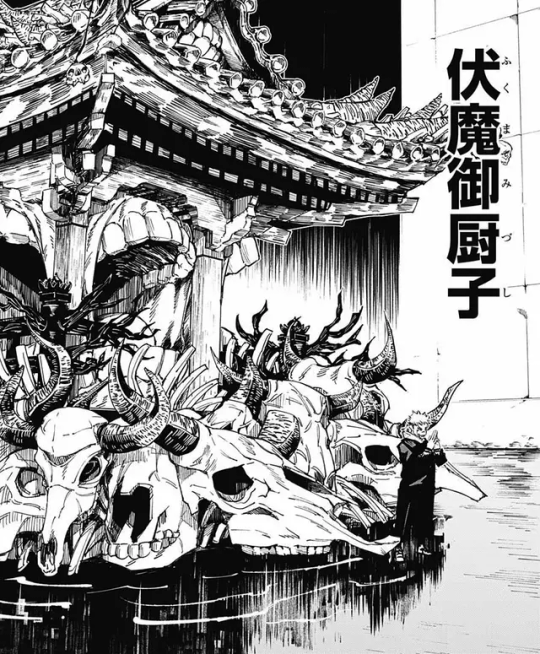
This symbolism also heavily influences Sukuna’s own manner of speech, and the way he speaks to other characters in the series as well. With his post-fight chat with Jogo before his death, Sukuna mentions Jogo lacking the “Hunger” to take control of his desires, preventing him from reaching the heights of Gojo Satoru. Before the Start of their fight in Shinjuku, Sukuna called Gojo a “Nameless Fish on top of his cutting board”, and that he was going to start by “Peeling off the scales”(refering to Gojo’s infinity). There’s also further symbolism that supports this by analyzing the Kanji and meaning of Sukuna’s “Malevolent Shrine” but I’m not very educated on that so I won’t be opening that point here.
What all of this points to is that Eating and Food……is extremely important to Sukuna, to the point that it literally affects him in manners innumerable.
Eating is an instinct, a necessity for the survival of every single living being.
And In the face of extreme Hunger and starvation, even those with the strongest will could lose their Humanity and revert to the basic animalistic side of their existence. (The Heian Period also had a Famine, although I believe the timing to be a bit off, but do with this info as you see fit)
In JJK Chapter 257, it is revealed to us that Sukuna and his Twin were most likely starving in the womb of their starving mother.
On the brink of starvation, Sukuna had to consume his “other self”(his twin), so that he could survive.
Btw, this tweet and this thread gives additional characterisation to Sukuna:

Link to the original thread: Link.
More context (and reactions :P):


Link to original thread: Here
This reveals to us that indeed, Sukuna was born a twin. And as we all know, “Twins” are seen with extreme scrutiny in Jujutsu Society, they’re not well liked. This too in a period where Cursed Spirits and Jujutsu Sorcery was at its peak, it is not far-fetched to assume that his Mother may not have been treated very well by the people in her surroundings, especially as she bore twins.
When Kashimo asks if Sukuna was born the Strongest or if he made himself the Strongest, this is the response Sukuna gave to him:

When you think about it, how do you think the people around them would have reacted when the woman: who was supposed to birth two twins, gave birth to a single child instead? and that child had consumed his other twin in the womb itself?
No doubt people would’ve been horrified, disgusted and even revulsed. With the woman and her newborn child.
This would’ve led to their further ostracisation in the already very close-minded society. Unable to fend for herself and her newborn child, it must’ve been difficult for Sukuna’s mother to survive. I feel like somewhere along the line, Sukuna was left alone to fend for himself at an extremely young age. To protect himself from both Curses and Society alike.
This is why I believe Sukuna knows what true starvation, weakness and hunger feels like. Both in the emotional and literal sense. He was left without another person caring about him or his well-being, in a cut-throat period where it was “Fight or be killed”.
Powerful curses roamed all across Japan, nowhere was safe. Simply be strong, or you'll die. There's no room for weakness. And initially, a kid!Sukuna was weak, as anyone would be in the beginning when they're just starting out in this world. (and maybe, he didn't have much to eat, leading to long periods of starvation? :') )
I believe it is this debilitating hunger, and feeling of weakness that eventually led to Sukuna’s current Hedonistic mindset.
He’s essentially traumatised by it, and believes that it was his own weakness that led him to experience this sheer starvation. That he deserved to feel this way because he was weak then. Perhaps, the people around him were right, that as long as they have the power and strength to overcome anything, they’re free to do as they please; And there is nothing anyone else could do about it.


I feel like the irony here is that Sukuna himself, must’ve been a “weakling” before eventually rising the ranks to become History’s Strongest Sorcerer. This is also why he values Strength so much.
Ultimately, Sukuna has decided that there was nothing more important than being strong enough to fulfill your own desires. And “eating” is one of his most important desires. It’s his favourite thing to do, the one he derives the most pleasure out of. And like an animal, whose main focus is to consume, consume and consume. He too, simply consumes.
Most morals likely have no meaning to him. He doesn’t care who he hurts, what he does, as long as he’s able to get what he wants. And this isn’t limited to eating.
This is why people referring to Sukuna as a “Natural Disaster” is so befitting of him. Because Natural Disasters also don’t care about what or who they’re destroying, they just come and go, wreaking havoc appropriate for their nature and magnitude.
I believe Sukuna himself has said lines similar in nature, when talking to Kashimo:

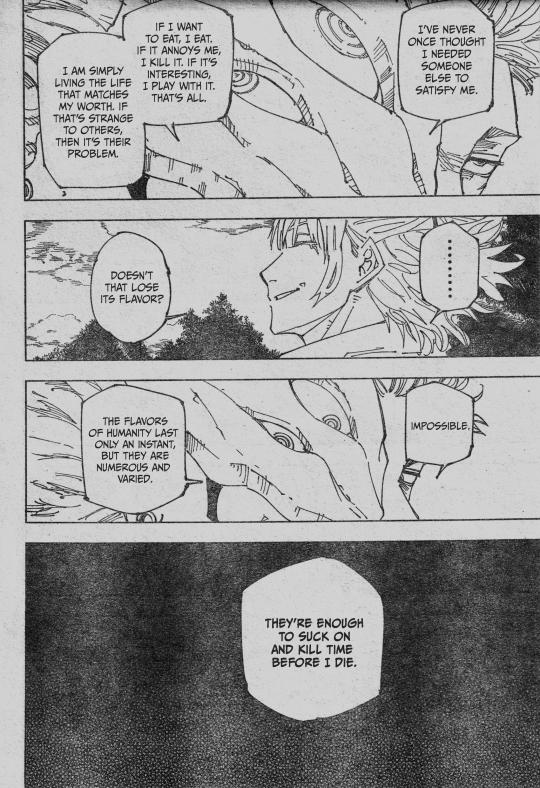
Now I’m not sure how Sukuna perceives or even experiences this “Love”, because I think he has a rather very warped idea of it. I do think that this definition of love is similar to the one that Gojo also understands, but I don’t think he knows what “love” truly is. I’m not sure how I could comment on this, but I do think that Sukuna’s emotionally starved, whether he realises that or not.
Because, like Kashimo himself asked Sukuna “What is the point of dividing your soul into 20 different parts and then traversing across time if you’re satisfied with this?” we do not know the answer to that yet.
But many people have speculated that “Black Box” panels in JJK manga represent a curse (either self-inflicted or put by someone) on the speaker. Like, take a look over here where Sukuna reiterates the same dialogue, except it looks like he’s trying to reassure himself:

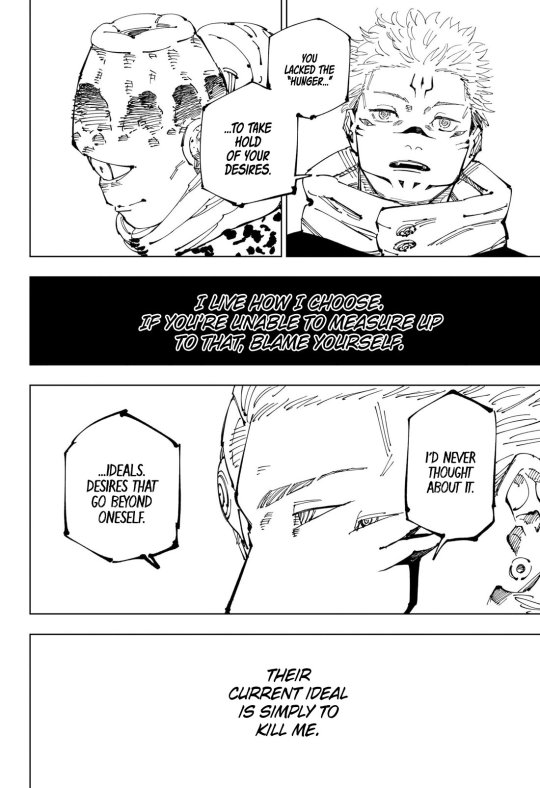
This once again shows that Sukuna has only ever strived for himself, in the same hedonistic fashion, to a very very extreme degree. It is possible that he's been lacking something, and he himself does not realise that he’s lacking it. Maybe it was this subconscious feeling, that led to Sukuna agreeing to Kenjaku’s plan of dividing his soul into 20 different parts, and to traverse across time as a Cursed Object.
Sukuna’s an incredibly complex character, and I’m excited to see where this goes. Gege has put extra care in the way he characterizes and depicts Sukuna, and again, I’m really sad that a lot of that characterization gets lost in translation. Still, I’m going to try my best to understand and get the most accurate feel of his character as I possibly can.
If you made it this far, Thank you for reading! And if you would like, please do leave a comment in the tags or replies because I would love to read what other people think of this and just Sukuna in general. I do not see a lot of people doing critical analysis of him, and a lot of his actions are seemingly swept under the rug. I don’t like that, so hopefully this contributes to people focusing more on Sukuna and his character. (/^v^)/ <3
#this chapter has revealed so much and i KNEW so many analysts were gonna jump on it#very good read!!#im gonna send this to my analyst friend i know she’s gonna love this#jjk#jujutsu kaisen#ryomen sukuna#sukuna#character analysis#jjk 257#reblog
250 notes
·
View notes
Text
jjk 257 spoilers
fixed the family tree in light of recent news aka a translation error

+ a nicer looking version
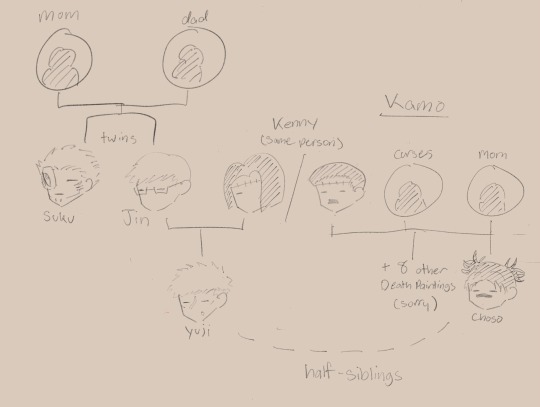
#jjk#jujutsu kaisen#jjk 257#jjk spoilers#sukuna#ryomen sukuna#itadori yuuji#itadori jin#kenjaku#jjk leaks
108 notes
·
View notes
Text
i guess this is the family tree ????
EDIT THIS IS NOT THE FAMILY TREE THERE WAS A TRANSLATION ERROR (fixed)

#jjk#jujutsu kaisen#jjk 257#jjk spoilers#jjk leaks#sukuna#ryomen sukuna#kenjaku#itadori yuuji#choso#jjk choso#itadori jin
24 notes
·
View notes
Text
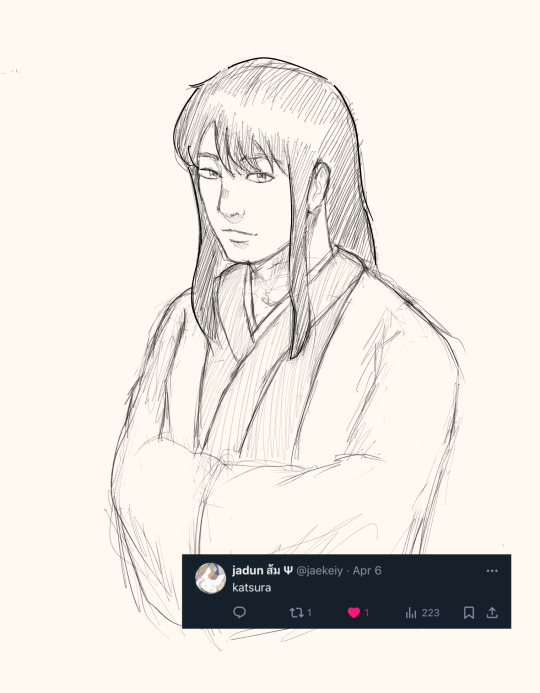



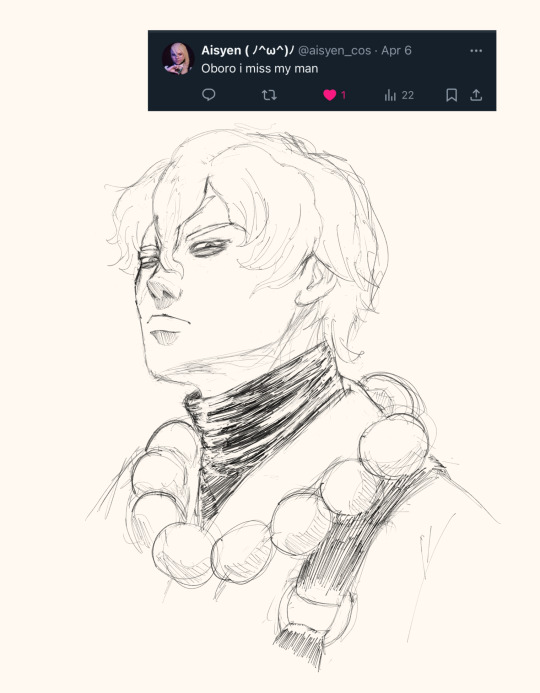
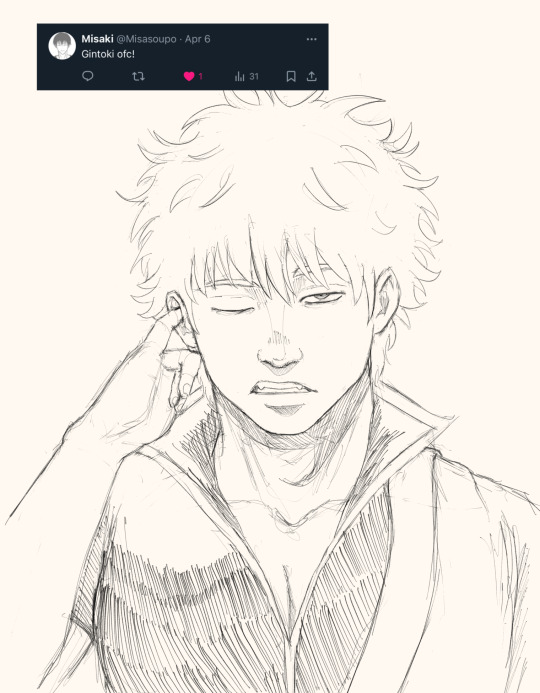

asked twt to give me gintama characters to doodle
#im gonna tell yall rn#the wavy hair duo gave me a hard time#their hair was definitely a struggle but i managed i think#i missed them so much and gintamatwt was going thru a revival so i was like heyyyyyyyyyy#bonkmasterdraws#gintama#katsura kotarou#gintama mutsu#imai nobume#yagyuu kyuubei#gintama oboro#sakata gintoki#sakamoto tatsuma
21 notes
·
View notes
Text
MF I THOUGHT THIS WAS A FATASS CAT
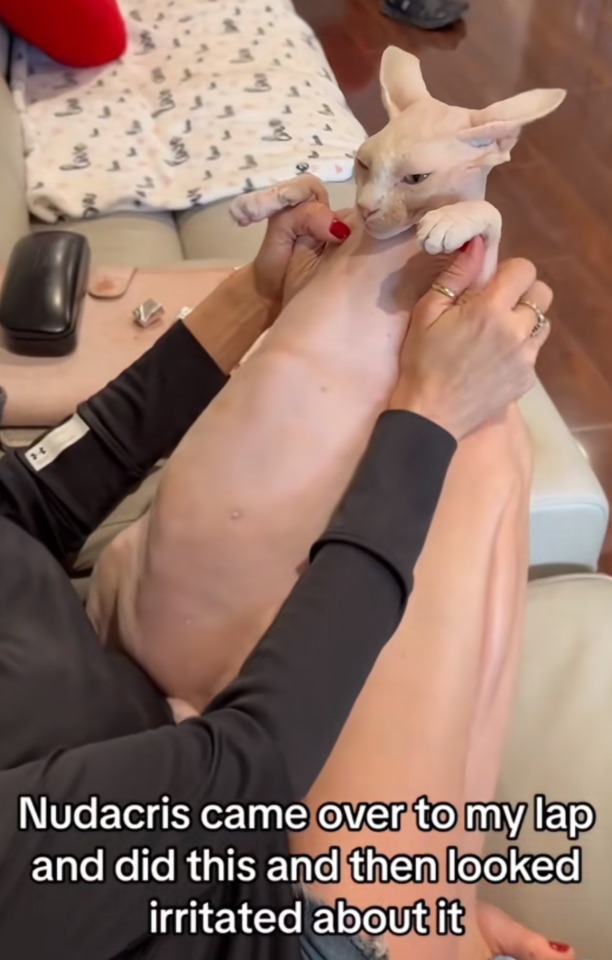
0 notes
Text
I CAN FINALLY SAY IT GRAAAAAAAAAAAAAAGHHHH

#lai turns 18 !!!#made the picture myself lollll#it’s a joke i’ve always wanted to say it and i can finally say it
1 note
·
View note
Text
i like using the tags and i wish many platforms had this function
i am so bad at communicating on tumblr
by god help me im not built for this
#this is so cool#there is something appealing in doing this#it’s like a P.S.#finding things is very easy with this function too#does the search allow filtering with multiple tags or only one?#if not they should have that
2 notes
·
View notes
Text
i am so bad at communicating on tumblr
by god help me im not built for this
2 notes
·
View notes
Text


#OH EM GEEEEEEE#love love love#gojo satoru#ryomen sukuna#sukuna#jjk#jujutsu kaisen#gosuku#sukugo#reblog
435 notes
·
View notes
Text
i watched the ‘how to fight’ livestream where they showed the first 2 eps early
it’s faithful to the og material, they capture every panel exactly (i watched it while going thru the manhwa), but the pacing was too fast . and i hate that we don’t get the full extent of hobin’s thoughts
5 notes
·
View notes
Text
now that’s its been confirmed suku made a binding vow for the world slash against gojo, ppl are still wondering what the exchange was .
i know the majority say he sacrificed the 10 shadows technique cus he hasn’t used it since but idk, it doesn’t make sense for him to just throw away a valuable CT like that . the condition simply was that he needed to perform the extra steps of activation (incantations and aim) after he transformed since the hand sign was the only requirement before .
basically: he had to make the hand sign to activate the world slash, couldn’t do so cus he was short one hand, made a binding vow to send one off without needing to meet the requirement and he now has to meet more requirements as a result of said vow .
edit: initially, this was a speculation post but reading back on the chapter (at least, what we have of it), it pretty much says so in the text so i edited it to be an explanation instead :]
20 notes
·
View notes
Text
W’s for miguel but at what cost 😭 gojo PR team is SCRAMBLING RN
#ITS HILARIOUS#twt is going insane#have yall seen the “thread of gojo’s actvism” posts after that#idk abt you guys but im having THE TIME OF MY LIFE lol this chapter was so entertaining to me#and here y’all thought sukuna was gonna say some sht 😭#on another note sukuna fans eating once again#jujutsu kaisen#jjk#jjk 255#jjk spoilers#gojo satoru#note: this is a joke i am joking and poking fun pls do not take this seriously
41 notes
·
View notes
Text
SAVE A COW, MILK THE WHAAAAAT ⁉️⁉️⁉️



#mutuals pls do not see me but also hear me out#sorry guys#why he kinda …………#i just had to ok all the other wips and sukuna can WAIT#that’s not my neighbor#milkman#francis mosses#bonkmasterdraws
227 notes
·
View notes
Text
HELLO AGAIN, SUKUNA ENJOYERS !! remember almost a month ago, i posted about part 1 of a friend’s sukuna lost in translation analysis ?
she just finished and posted a part 2 !! for those who have been waiting for it, it’s here now ! there’s no “lost in translation” in this one, mainly an analysis going deeper into sukuna’s character which i think many will enjoy .
again, user is @/societyhater_ !!
some images below so people have an idea of how it’s structured. link to the full version will be after the selected images so please read the whole thing if you are interested!
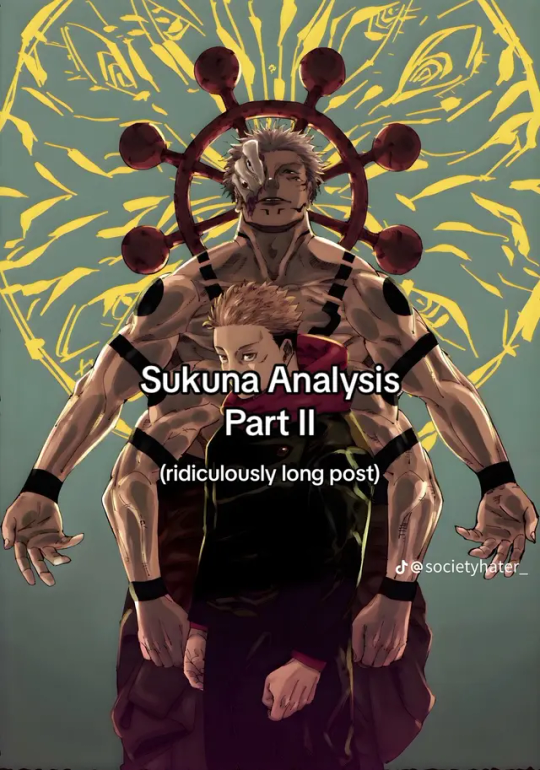
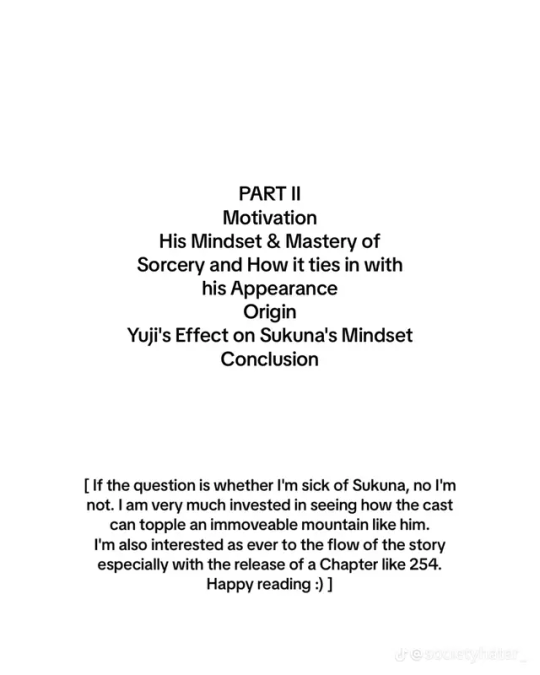
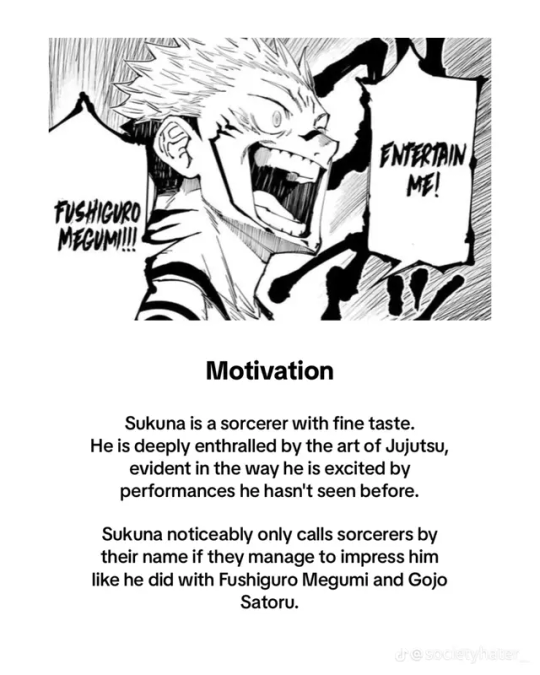
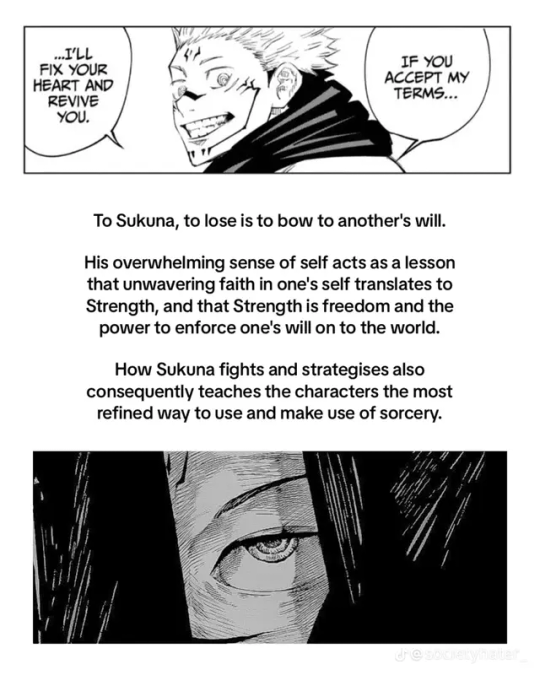




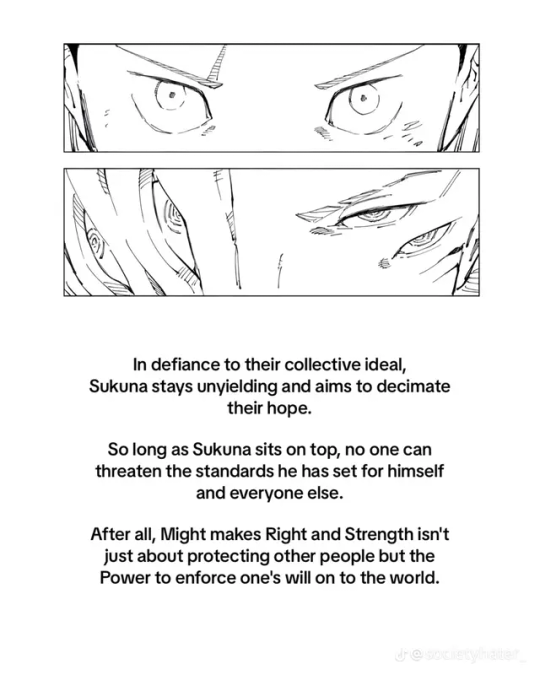
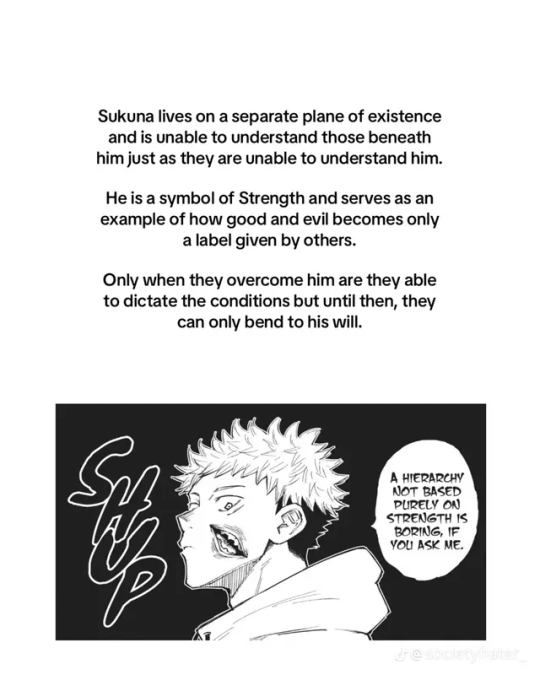
#part 2 of the suku analysis !!#again i recommend checking out her other posts too :]#another banger ueheuehe#jujutsu kaisen#jjk#sukuna#ryomen sukuna#manga analysis#text analysis#character analysis
27 notes
·
View notes
Text
made an impulse decision to bring suku-nendo with me on a trip

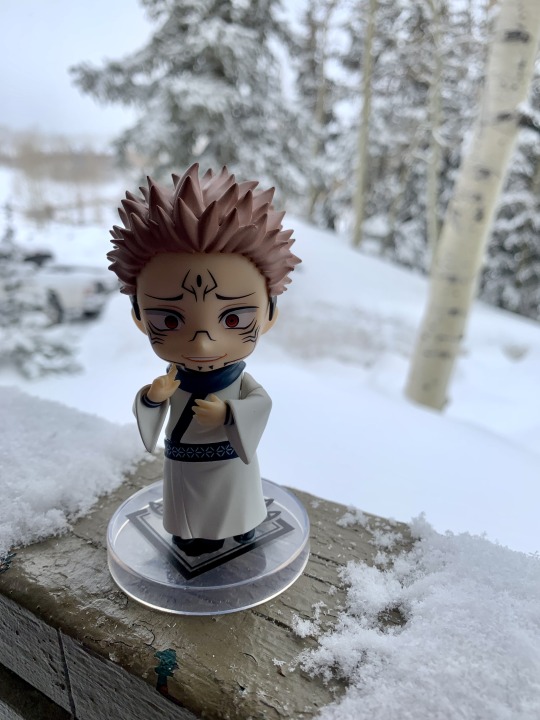
55 notes
·
View notes